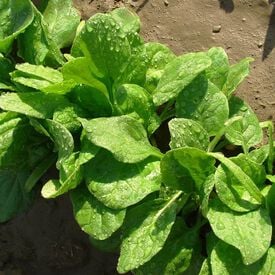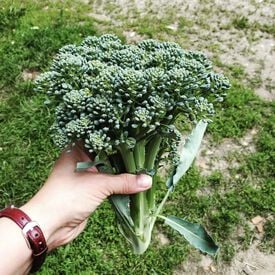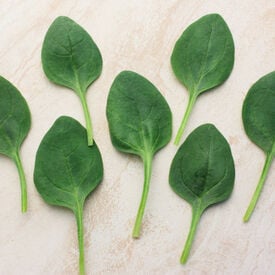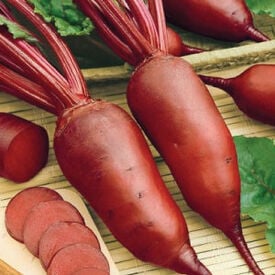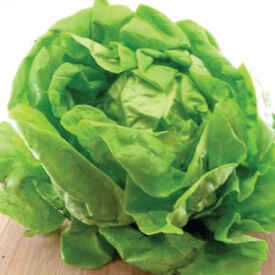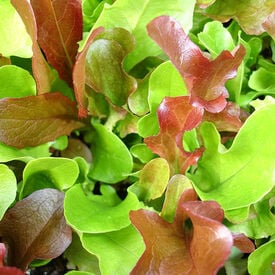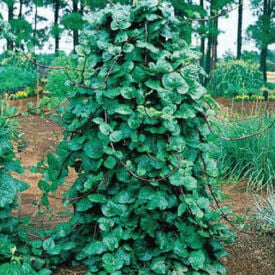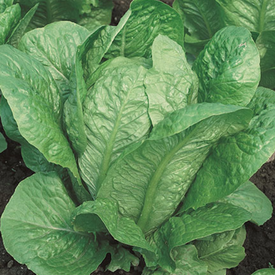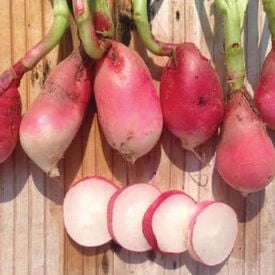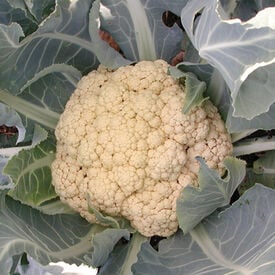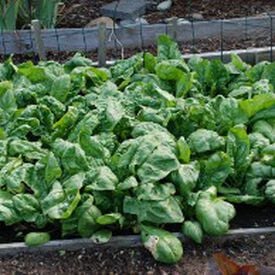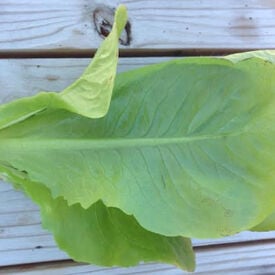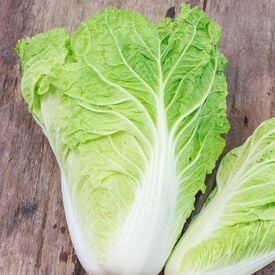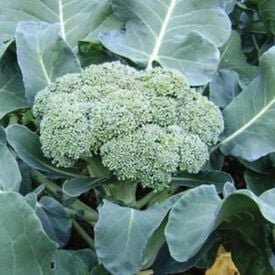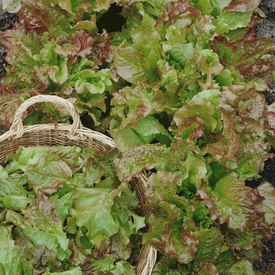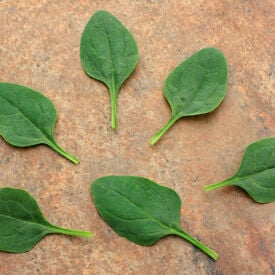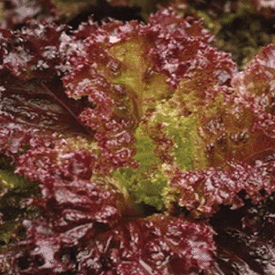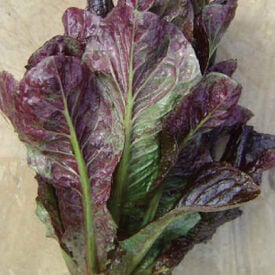The Viroflay Spinach is a gourmet French heirloom that was developed prior to 1866. The big, smooth leaves of this Spinach variety is a deep green color and grows up to 10 inches long. This very fast growing plant is popular for fall planting.
Waltham 29 broccoli seeds produce a classic, open-pollinated variety that was developed in the early 20th century by the University of Massachusetts at Waltham and has remained a trusted garden standard ever since. This variety forms large, deep blue-green central heads measuring 6–8" across on sturdy, cold-tolerant plants that typically reach 20–24" tall. Known for its reliability and adaptability, Waltham 29 performs especially well in cooler temperatures and is valued for its uniform growth and strong side-shoot production after the main head is harvested, resulting in generous yields over an extended period. It matures in about 74–85 days from transplant, making it well suited for spring and fall planting. The tightly packed florets have a tender texture and mild, slightly sweet flavor, excellent for fresh eating, steaming, freezing, and a wide range of culinary uses.
Lakeside smooth leaf spinach with dark green leaves. It has a round to oval leaf shape with an upright plant habit that makes it easy to harvest. It is a very versatile variety it can be used for baby leaf, bunch or clip.
Cylindra beets, also known as "Formanova" or "Butter Slicer," are a unique variety of beetroot known for their elongated, cylindrical shape. These beets have a fascinating history, originally hailing from Europe, particularly Denmark, where they were developed in the early 20th century. Their distinctive shape was cultivated to make them easier to slice and can, a practical innovation that has made them popular among home gardeners and commercial growers alike. In terms of taste, cylindra beets are mild and sweet, with a slightly earthy flavor. They are known for their tender, non-fibrous texture, making them excellent candidates for pickling, roasting, or slicing thinly for salads. Their deep red-purple skin contrasts beautifully with the vibrant, dark red flesh inside, adding an attractive element to culinary dishes. Cylindra beets typically grow to be 6-8 inches in length and 2 inches in diameter. They are ready for harvest in approximately 55-65 days from planting, making them a relatively quick-growing beet variety. They thrive in well-drained, loamy soil with full sun exposure. When it comes to disease resistance, cylindra beets tend to be more resistant to common beet diseases like leaf spot and powdery mildew than some other beet varieties. Proper spacing is crucial, with about 2-3 inches between each plant and rows spaced 12-18 inches apart. With the right care and growing conditions, cylindra beets can yield a bountiful crop of these delicious and uniquely-shaped vegetables, making them a favorite among gardeners and chefs.
Bibb is a crisp, clean, and easy to grow butterhead lettuce that has light green leaves with the occasional red spots. The crispy heads often self blanch in the center. This lettuce variety is perfect for farmers markets and for the home gardener. This Bibb does well in the heat, yet still grows quickly in our cool weather. Lt. John B. Bibb served in the War of 1812, represented Logan County in the Kentucky House of Representatives and the state Senate from 1827 to 1834. Lt. Bibb was also an amateur horticulturist and developed the Bibb lettuce we know and love today. However, it wasn't offered commercially until 1935.
The Garden Mesclun Blend is a mixture of light green to emerald, and bronze to deep red lettuces as well as endive and radicchio for a crunchy, zesty flavor that is a perfect addition to any salad!
Red Malabar spinach (Basella rubra) is a heat-loving, vining green that thrives through the hottest days of summer when traditional greens fade. This vigorous Asian vine features glossy, thick, slightly savoyed dark green leaves set against striking deep red to purple stems, making it as ornamental as it is edible. The mild, chard-like flavor works well when young leaves and tender stems are used fresh in salads, blended into smoothies, or lightly cooked in stir-fries. Exceptionally tolerant of heat and humidity, it produces an abundance of nutritious greens well into fall, along with deep purple berries rich in anthocyanins that can be used as a natural dye. Not a true spinach, this beautiful plant is typically grown as an annual in cooler regions and as a perennial in subtropical climates, but it is not frost hardy.
The Vivian lettuce is a tightly bunched romaine with broad dark green crisp leaves. Its leaves are 12-16 in. long and 4-6 in. across. Vivian is bolt resistant and suitable for commercial and home growers. Its erect dark green leaves are great for baby leaf production.
The French Breakfast Radish has a delicate flavor and is an excellent variety for home gardens. This radish variety is an attractive uniquely shaped radish with elongated roots and red tops with white tips. The French Breakfast has an excellent flavor and texture, that is perfect for dips or as a garnish.
The Snow Crown cauliflower is a delicious, mild and sweet hybrid. This cauliflower's head will get to 7-8 inches across and 1-2 pounds. The Snow Crown is extra early and adaptable and can be harvested in summer or fall. Be careful not to under-fertilize or water, stress can cause a purplish discoloration on the undersides of the head.
The Olympia is a top-notch smooth leaf hybrid spinach that has a great flavor. This spinach Hybrid has thick and dark green leaves that grow upright. The Olympia is highly recommended for spring, summer, fall and over wintering crops because it resists bolting under high temperatures and long day conditions. Treated seed.
The Winter Density Lettuce is a favorite cold weather Romaine! This variety produces compact, extra-dark green heads that are 8" tall and very tightly folded. The Winter Density gets its name for doing well in the cold weather!
Michihili cabbage is great for those who love stir-fry or pickling cabbage. A tight-head type with well blanched, crisp and tender interior. Michihili produces a cylindrical, leafy head. A high yielding cabbage with excellent flavor. Chinese cabbage nutrients include vitamins A and C.
Calabrese Green Sprouting broccoli is a popular and nutritious vegetable known for its tender florets and robust flavor. Originating from Italy, specifically the Calabria region, this variety was cultivated for centuries before gaining popularity worldwide, especially in home gardens and markets. Calabrese broccoli include its sturdy, upright stalks and large, vibrant green heads that typically form in loose clusters. The color is a rich, dark green, with tightly packed florets that can range from small to medium-sized. When cooked, Calabrese broccoli offers a slightly sweet and earthy flavor, making it a versatile ingredient in a variety of dishes, from stir-fries to soups. An appealing attribute of Calabrese is its ability to produce side shoots after the main head is harvested, providing multiple harvests throughout the season. This variety is also valued for its nutritional benefits, being rich in vitamins C and K, fiber, and antioxidants. Its hardiness and adaptability make Calabrese green sprouting broccoli a favorite among gardeners and cooks alike.
The Santa Fe Lettuce produces a small blanched head that is surrounded by green outer leaves with a tinged bronze-red tip. This variety is a favorite for being extra crunchy!
Riverside is a smooth spinach with dark green leaves. Grown mostly for its spade-shaped baby leaf harvesting. Riverside produces at normal rates with an upright plant habit. Excellent for growers who want premium quality product. Riverside is also very resistant to downy mildew.
Lolla Rossa lettuce is a beautiful Italian heirloom variety originating from the Lolla region near Bergamo, known for its striking deep-red, frilly leaves and crisp texture. Typically forming compact, loose-leaf rosettes about 6 to 8 inches across, it adds vibrant color and visual appeal to salads and garden beds alike. The leaves are tender yet slightly crunchy, offering a mild, slightly bitter flavor with a subtle nutty finish. Lolla Rossa thrives in cool weather and prefers full sun with well-drained, fertile soil rich in organic matter. It grows best in temperatures between 45–70°F and benefits from consistent moisture, making it ideal for spring and fall planting.
Red Romaine Lettuce has long, crinkled leaves with great crunch! This variety starts green and fades to redish-purple. The Red Romaine's leaves are12" tall and the plant is about 10-12" wide. This lettuce is often used in Caesar salads not only for its crunch, but also for its color. Use Red Romaine lettuce for an incredible edible purple border in your flower beds.
